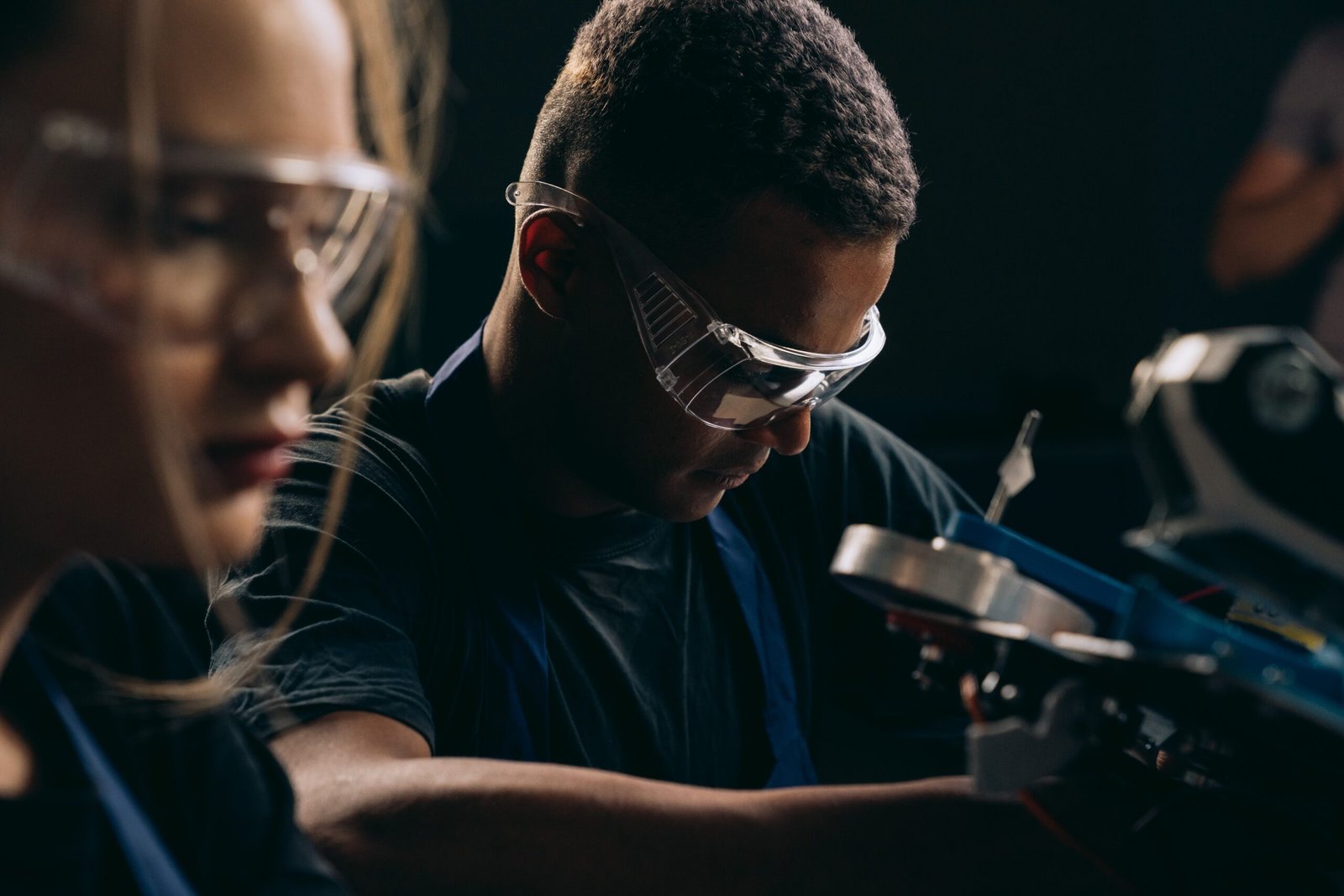Industrial Robotics And Digital Manufacturing
Introduction:
Manufacturing sectors employ industrial robots in a variety of ways. Including factories and warehouses. In the present manufacturing landscape. These robots hold a crucial position in the realm of automation resulting in substantial production growth. Through the utilization of industrial robotics and digital manufacturing can lower production expenses, accelerate manufacturing processes, and enhance overall product quality.
While there exists a notable initial investment in procuring industrial robots. The ensuing benefits are equally substantial. Consequently the efficiency they bring to manufacturing processes makes them a worthwhile investment. This article will explore key industrial robot applications highlighting their significance in different operational areas.
A guide to understanding industrial robots:
Industrial Robotics And Digital Manufacturing are machines that are programmed to carry out a range of manufacturing tasks.Particularly within the automotive sector. These robots are employed across diverse industries to facilitate flexible automation and manage large-scale production volumes. Capable of executing intricate sequences of actions.They effectively curtail production timelines.
During the early 1960s, General Motors adopted the pioneering UNIMATE as its first industrial robot. In contemporary manufacturing robots assume multifaceted roles encompassing tasks like material handling and packaging.
Consequently their design centers on executing a variety of repetitive tasks thus minimizing production duration. Notably these industrial robots incorporate Artificial Intelligence and machine learning systems. Enabling manufacturers to swiftly address real-time scenario
Industrial robots work:
Robotics and automation are evolving rapidly. Technology has led to a surge in the integration of industrial robots within manufacturing domains. This trend is further fueled by the deployment of numerous industrial robots. Each capable of executing diverse tasks with consistent precision. Thereby contributing to high-quality production. Consequently a variety of industrial robotic applications have emerged in the manufacturing sector. In this context. We will tour fundamental categories of industrial robots.
Articulated Robots:
Articulated robots represent commonplace industrial robotic systems. That exhibits a mechanical structure akin to human arms. Resembling the configuration of a human arm.These robots possess a base to which the arm is affixed through a configuration resembling twisted joints.
The arm of articulated robots is equipped with rotary joints that run parallel.Furnishing them with six degrees of freedom. This sextuple range of motion within articulated robots imparts an unparalleled level of flexibility and adaptability.
Cartesian Industrial Robotics:
Rectilinear robots, also known as gantry robots, are alternatively referred to as Cartesian robots. These robots adopt a rectangular structure and incorporate three prismatic joints. Some Cartesian robots might include a wrist component linked to their joints. Enabling rotational movement as well. Renowned for their heightened flexibility. These robots find utility across diverse manufacturing sectors rendering them apt for fulfilling specific application requirements.
Robotics Industrial:
Selective Compliance Assembly Robot Arm robots are calmed by two parallel joints. Which constitute their distinctive structure. These robots feature an envelope with a donut-like shape that imparts compliance in a single direction. The arm attached to a rotary shaft assumes a vertical orientation while enabling horizontal movement. Consequently in comparison to cylindrical and Cartesian robots exhibit swifter motion capabilities and offer simplified integration processes.
Delta-Industrial Robotics:
Delta robots, also known as Parallel link robots are characterized by their mechanical composition comprising parallel joint linkages connected to a shared base. These robots are specifically designed to deliver rapid operation, making them particularly suitable for swift pick-and-place transfer tasks.
Polar-Industrial Robotics:
Polar robots feature twisted joints that are affixed to the arm. Accompanied by two rotary joints and a linear joint interconnecting the links. This configuration imparts a spherical work envelope. Rendering them akin to Spherical robots. However it’s worth noting that the accessibility of this opposing robot arm configuration is constrained within its designated workspace.
Industrial Robotics Applications: How do they work?
A combination of sensors, controllers, and actuators is used by industrial robots to carry out diverse manufacturing tasks. These robots execute repetitive movement sequences as programmed by manufacturers using a predetermined set of instructions.
Furthermore robots represent a significant stride towards creating machinery that minimizes human involvement. Their utility extends to various manufacturing processes and environments unsuitable for human presence such as outer space high-temperature zones, and underwater domains.
These machines are tailored to function in hazardous settings. Encompassing activities like inspecting radioactive materials and defusing explosives. Programmability defines robots enabling them to traverse along three or more axes. Consequently. Their versatility lends itself to a range of conventional applications including welding assembly and painting.
Top Industrial Robotics:
There are some Top Industrial Robotics And Digital Manufacturing
- Assembly and Dispensing
- Handling and Picking
- Machining and Cutting
- Welding and Soldering
- Casting and Molding
- Finishing and Sanding
- Painting and Coating
- Cleaning and Hygiene
- Logistics and Storage
- Inspection and Quality Control
- Packing and Palletizing
- Harvesting
Assembly and Dispensing:
In modern manufacturing the process of assembling smaller components into larger units has been revolutionized by the integration of robots. Technological advancements have enabled robots to perform multiple tasks concurrently. Especially in adhesive-heavy assembling operations adhesive robots play a pivotal role due to their ability to handle sticky materials effectively.
Assembly robots typically configured in a Cartesian setup are firmly anchored to the floor and cannot change positions rapidly. The automotive industry was among the pioneers in adopting assembly robots. High-speed robots specialized in tasks like dispensing glue and epoxy have found essential roles in production processes.
Handling and Picking:
Handling robots facilitate the movement of goods within warehouse settings. While picking robots excel in picking up and placing items into shipping containers. These robots have proven invaluable for e-commerce companies enhancing efficiency and speed in order fulfillment. Material handling robots, liquid handling robots and pick-and-place robots all fall under the umbrella of handling and picking robots.
Machining and Cutting:
Repetitive operations are a cornerstone of manufacturing and automation through robots is the ideal solution. The machining and cutting sectors demand precision and consistency making robots indispensable. Machine tending and loading robots, milling robots, drilling robots, laser cutting robots, plasma cutting robots and waterjet cutting robots are tailored for various machining and cutting tasks.
Welding and Soldering:
In industrial contexts welding employs electricity to fuse metal pieces, creating durable connections upon cooling. Arc welding robots streamline this process through automation enhancing efficiency and accuracy. Similarly, soldering, involving the application of melted filler material to joints is expedited by soldering robots leading to faster automated outcomes.
Casting and Molding:
Casting involves injecting liquid metal into cavities to create metallic objects. While molding uses different materials such as plastic to achieve a similar result. These process essential for manufacturing have embraced automation through robots. Injection molding robots, finishing robots, and sanding robots are vital players in the casting and molding domain.
Finishing and Sanding:
The finishing and sanding process removes unwanted material ensuring the final product meets quality standards. Deburring robots grinding robots and polishing robots streamline these tasks particularly in sectors like casting welding and drilling. Where residue must be eliminated for a polished outcome.
Painting and Coating:
Applying coatings to workpieces constitutes industrial painting and coating. This repetitive task is ideal for automation, enhancing precision and efficiency. Painting robots, spray painting robots, and coating robots excel in this domain, delivering consistent and flawless results.
Cleaning and Hygiene:
Maintaining cleanliness and hygiene in industrial facilities is paramount for product quality and employee safety. Robotic cleaning solutions streamline. These repetitive tasks ensure consistent and thorough cleaning processes.
Logistics and Storage:
Industrial robots play a crucial role in logistics transportation packaging labeling and other warehouse operations also Warehouse robots and delivery robots facilitate efficient movement of goods and contribute to automation in supply chain management.
Packing and Palletizing:
Industries involving packaging and palletizing benefit from the efficiency and precision of robots. Packaging robots and palletizing robots streamline processes in warehouses manufacturing, and distribution centers ensuring consistent and accurate packaging.
Inspection and Quality Control:
In critical industries such as aerospace and healthcare inspection and quality control must ensure precision and safety. Vision robots are employed to achieve impeccable accuracy reducing the likelihood of errors and enhancing quality assurance.
Harvesting:
For time-sensitive crops like fruits and vegetables timely harvesting is essential to maintain product quality. Harvesting robots ensure efficient and accurate harvesting contributing to the agricultural sector’s productivity.
Conclusion:
In this Industrial robotics and digital manufacturing summation the breadth of applications for industrial robots in the manufacturing sector is expansive. The diverse applications discussed illustrate the pivotal role robots play in enhancing quality, reducing cost and improving workplace safety. However, These robots have become integral to various industries shaping the future of manufacturing.














Post Comment